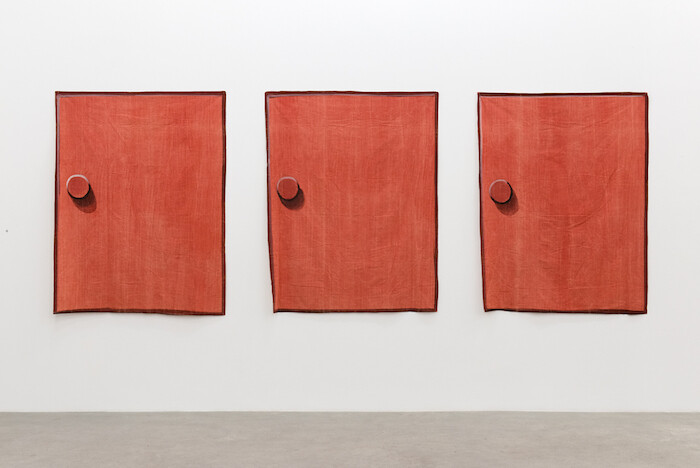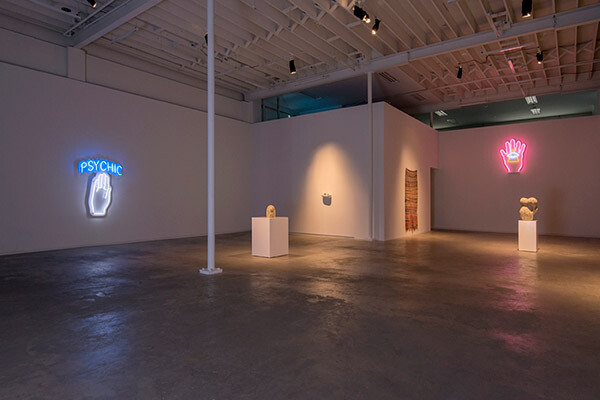Categories
Subjects
Authors
Artists
Venues
Locations
Calendar
Filter
Done
February 14, 2017 – Review
Geoffrey Farmer’s “The Big Kitchen”
Rob Stone

Geoffrey Farmer’s lyricism of control is on show at Catriona Jeffries Gallery, although this time with a new suggestion of malignity. Farmer is an exponent of the artistic practice of finding a part of a derelict, languishing image, or two, or more, and through juxtapositions translating these elements into novel, revealing modern utterances. In his 2013 installation “The Surgeon and the Photographer” at London’s Barbican Centre, for instance, he assembled garlands of excised fragments—a part of a statue here, a leaf, a limb, or garment there—to fashion a community of hundreds of tiny, miscegenous personages in whom you sensed love for themselves and each other.
For this new show, he has discovered and rescued an enormous, painted canvas theatrical backdrop. Made by the set design company R.L. Grosh and Sons on Sunset Boulevard in 1939, it depicts a hellish red kitchen. Farmer takes care to make sure that we know its provenance, and also shares in his notes on the exhibition that kitchens have been significant for him: a source of mystery, worry, and danger, of cold coffee and hard crusts, but also consolation. He seems concerned that the momentousness of these things is now receding in his memory. Cut-out elements …
April 7, 2015 – Review
Myfanwy MacLeod’s “Tell Her Nothing She Tells All”
Tyler Coburn

Shopfront esoterica and modernist sculpture rub shoulders in “Tell Her Nothing She Tells All,” Myfanwy MacLeod’s current exhibition at Catriona Jeffries, Vancouver. Borrowing its title from a slogan common to psychic shops, the show continues MacLeod’s interest in using pop and vernacular languages to, as she puts it, “speak to more profound things.”
MacLeod is better spoken than most; over the past 20 years, she has quoted everything from muscle car to moonshine still, Playboy pinup to barn hex. At their best, these references do more than just level the cultural field. Tiny Kingdom (2001), for example, replicates the outhouse from the 1968 film Chitty Chitty Bang Bang. Reflecting on the work, MacLeod proposes “the outhouse as a symbol of Canadian national identity”—an undignified marker of the country’s colonial past. For a recent public art commission, she fabricated two sixteen-foot-tall sparrows, which flank a plaza that served as the 2010 Vancouver Olympic Village (The Birds, 2010). MacLeod has described choosing sparrows not only for their insufferable cuteness, or their Hitchcockian portent, but also for being non-natives of North America that grew into a dominant species. As these works demonstrate, the artist excels at turning known quantities into platforms for social commentary.
“Tell …
November 21, 2011 – Review
"People Things Enter Exit"
Aaron Peck

The adjective shared by most of the work in this exhibition is “dramaturgical.” So I want to stage this review in three different “acts,” each of which deals with some aspect of the exhibition.
Act One: Theatricality. The original impetus of “People Things Enter Exit” was to put the work of Judy Radul and Geoffrey Farmer into dialogue. Both artists work in what might be called a “theatrical” way, and Radul, specifically, has written about her own work contra Michael Fried’s use of the word to critique minimalism. Other artists were then included in the exhibition to give both historical and contemporary context, an inspired inclusion that not only opened up how one thinks about Farmer’s and Radul’s work, but also how all the works relate to each other. Each of the works here has some connection to theatre or performance and, in that way, can be seen in the context of this critique of theatricality.
Act Two: Objects. Another way to think about the exhibition is through its objects, none of which presuppose the existence of a spectator. Or, rather, if the work does position a spectator, it implicates him or her as one thing among many. The exhibition asks a …